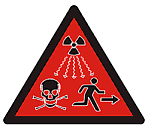Radiation Terms and Definitions-03
Radiation Terms and Definitions-03
This page provides a list of general terms that are used to describe aspects of radiation science. Click on the desired term from the list to retrieve the definition for the term.
Gamma radiation
High-energy, short wavelength, electromagnetic radiation emitted from the nucleus of an atom. Gamma radiation frequently accompanies the emission of alpha and beta particles and always accompanies fission.
Gamma rays
Very penetrating and are best stopped or shielded by dense materials, such as lead or uranium. Gamma rays are similar to x rays.
Gaseous diffusion plant
A facility where uranium hexafluoride gas is filtered, uranium-235 is separated from uranium-238, increasing the percentage of uranium-235. The process requires enormous amounts of electric power.
Geiger-Mueller Counter
A radiation detection and measuring instrument. It consists of a gas-filled tube containing electrodes, between which there is an electrical voltage, but no current flowing. When ionizing radiation passes through and ionizes the gas within the tube a short, intense pulse of current passes from the negative electrode to the positive electrode and is measured or counted. The number of pulses per second is an indication of the rate at which ionizing events are occurring within the tube. It was named for Hans Geiger and W. Mueller, who invented it in the 1920s. It is sometimes called simply a Geiger counter or a G-M counter, and is the most commonly used portable radiation instrument.
Gray (Gy)
The international system (SI) unit of radiation dose expressed in terms of absorbed energy per unit mass of tissue. The gray is the unit of absorbed dose and has replaced the rad. 1 gray = 1 Joule/kilogram and also equals 100 rad.
Half-life
The time in which one-half of the activity of a particular radioactive substance is lost due to radioactive decay. Measured half-lives vary from millionths of a second to billions of years. Also called physical or radiological half-life.
Ionizing-Radiation Warning Symbol

A radiation warning symbol, to supplement the existing trefoil symbol, has been published by ISO as Standard #21482 - Ionizing-Radiation Warning—Supplementary Symbol. The new symbol is a universal radiation warning symbol with the message of "Danger-Stay Away". It is intended for IAEA Category 1, 2, and 3 sources defined as dangerous sources capable of causing death or serious injury. It should be placed on the device housing the source, as a warning not to dismantle the device or to get any closer. Where practical, it should be placed under the device cover such that it is not visible under normal use but would be visible if anyone attempts to disassemble the device. The symbol is not intended for doors or shipping containers.
Isotope
One of two or more atoms with the same number of protons, but different numbers of neutrons in their nuclei. Thus, carbon-12, carbon-13, and carbon-14 are isotopes of the element, carbon, the numbers denoting the mass number of each isotope. Isotopes have very nearly the same chemical properties, but often have different physical properties. For example, carbon-12 and carbon-13 are stable; carbon-14 is unstable, that is, it is radioactive.
More details, please visit www.tungsten-alloy.com.
If you need any more details of the above news and/or products, please visit Chinatungsten Online, or contact us directly.
Disclaimer: The article is only reflecting the opinions of the author. We have no responsibility to prove the originality and authenticity of the content, words and/or pictures. You readers should just take it as reference and check the details by yourselves. And the content is not a suggestion for investment decision. The investor takes his or her own risks if he or she operates accordingly. If you have any dissent about the contents above, please contact the relevant author, or the webmaster. We will try our best to assist the dealing of the related issues. Thanks for your visit and cooperation.
|


